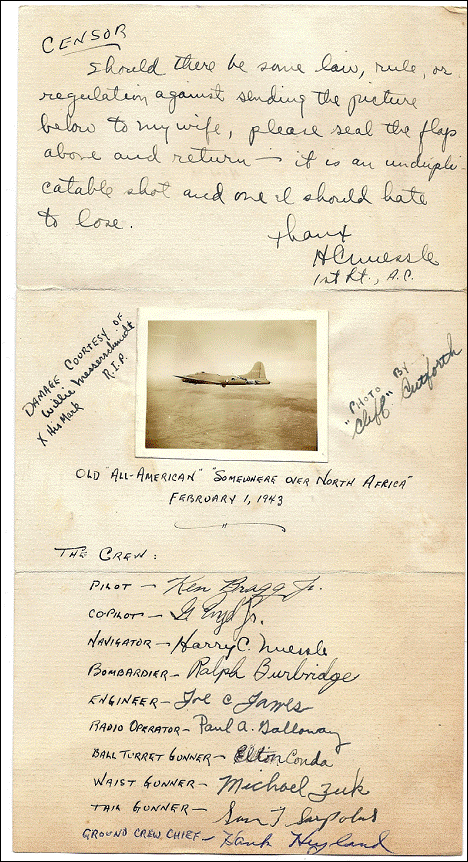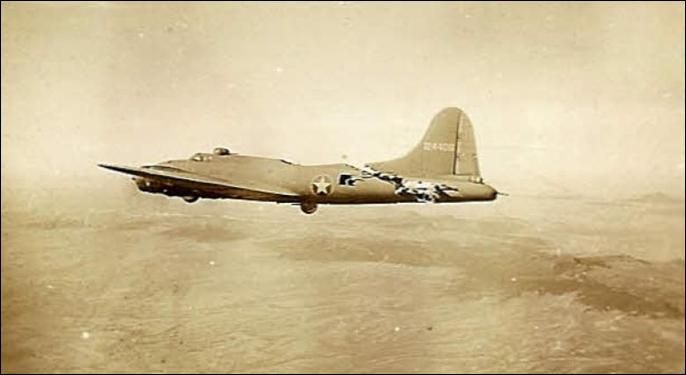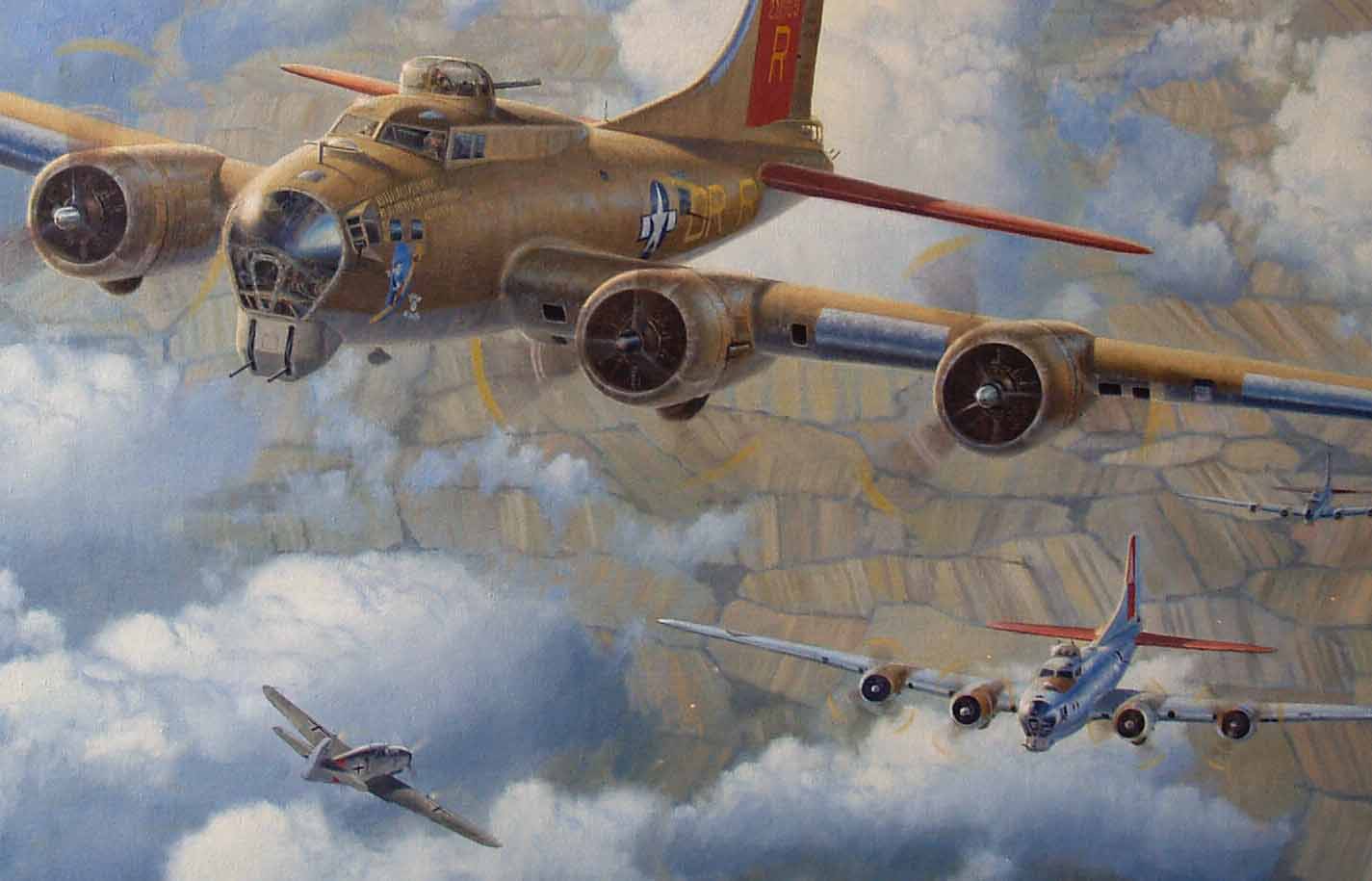
Posted on 09/02/2012 8:54:46 AM PDT by Windflier
WWII B-17 Survival Story

B-17 in 1943
A mid-air collision on February 1, 1943, between a B-17 and a German fighter over the Tunis dock area, became the subject of one of the most famous photographs of World War II. An enemy fighter attacking a 97th Bomb Group formation went out of control, probably with a wounded pilot then continued its crashing descent into the rear of the fuselage of a Fortress named All American, piloted by Lt. Kendrick R. Bragg, of the 414th Bomb Squadron. When it struck, the fighter broke apart, but left some pieces in the B-17. The left horizontal stabilizer of the Fortress and left elevator were completely torn away. The two right engines were out and one on the left had a serious oil pump leak. The vertical fin and the rudder had been damaged, the fuselage had been cut almost completely through connected only at two small parts of the frame and the radios, electrical and oxygen systems were damaged. There was also a hole in the top that was over 16 feet long and 4 feet wide at its widest and the split in the fuselage went all the way to the top gunners turret.
Although the tail actually bounced and swayed in the wind and twisted when the plane turned and all the control cables were severed, except one single elevator cable still worked, and the aircraft still flew - miraculously! The tail gunner was trapped because there was no floor connecting the tail to the rest of the plane. The waist and tail gunners used parts of the German fighter and their own parachute harnesses in an attempt to keep the tail from ripping off and the two sides of the fuselage from splitting apart. While the crew was trying to keep the bomber from coming apart, the pilot continued on his bomb run and released his bombs over the target.
When the bomb bay doors were opened, the wind turbulence was so great that it blew one of the waist gunners into the broken tail section. It took several minutes and four crew members to pass him ropes from parachutes and haul him back into the forward part of the plane. When they tried to do the same for the tail gunner, the tail began flapping so hard that it began to break off. The weight of the gunner was adding some stability to the tail section, so he went back to his position.
The turn back toward England had to be very slow to keep the tail from twisting off. They actually covered almost 70 miles to make the turn home. The bomber was so badly damaged that it was losing altitude and speed and was soon alone in the sky. For a brief time, two more Me-109 German fighters attacked the All American. Despite the extensive damage, all of the machine gunners were able to respond to these attacks and soon drove off the fighters. The two waist gunners stood up with their heads sticking out through the hole in the top of the fuselage to aim and fire their machine guns. The tail gunner had to shoot in short bursts because the recoil was actually causing the plane to turn.
Allied P-51 fighters intercepted the All American as it crossed over the Channel and took one of the pictures shown. They also radioed to the base describing that the empennage was waving like a fish tail and that the plane would not make it and to send out boats to rescue the crew when they bailed out. The fighters stayed with the Fortress taking hand signals from Lt. Bragg and relaying them to the base. Lt. Bragg signaled that 5 parachutes and the spare had been "used" so five of the crew could not bail out. He made the decision that if they could not bail out safely, then he would stay with the plane and land it.
Two and a half hours after being hit, the aircraft made its final turn to line up with the runway while it was still over 40 miles away. It descended into an emergency landing and a normal roll-out on its landing gear.
When the ambulance pulled alongside, it was waved off because not a single member of the crew had been injured. No one could believe that the aircraft could still fly in such a condition. The Fortress sat placidly until the crew all exited through the door in the fuselage and the tail gunner had climbed down a ladder, at which time the entire rear section of the aircraft collapsed onto the ground. The rugged old bird had done its job.








I hadn't noticed that until someone pointed it out upthread. I've got to agree. That one element of the story can't possibly be correct, although I don't think it detracts from the meat of the report.
The Boeing B-17 is still one of the toughest war birds ever built.
I don’t think it was a question of workmanship as much as design. A lot of American World War II aircraft were sledgehammers, the P-47, the F-6 Hellcat, all the Boeing bombers. The Lancaster was mostly used for night bombing for a reason, they simply would not have survived daytime flying over Germany.
The Lancaster was an impressive weapon and superbly flown and employed, but it was nowhere near as rugged as the B-17.
In that book there is a account of a B-17 landing in England
with no crew aboard. It touched down near a British AA battery.
The first people to access the aircraft got the engines shut
down by trial and error. And while in the plane noticed that
what they thought to be parachutes still in the plane. Turns
out that what they thought to be parachutes were actually
protective bags for the chest type chutes. The crew had bailed
out over the channel with the auto pilot on. The engines
were not making enough power for them to get home so they
bailed. I guess that the engines either picked back up again
or the reduced weight, the crew having left the airplane was
just enough for the plane to get back to England, by itself.
Mike
I heartily agree. I've loved that plane since I was a kid. It's still number one in my book.


Thanks for adding that clarification to the story, DC. Much appreciated.
It seems I was off a day on the book title. It is Actually
titled “Black Thursday”.
Mike
Windflier, thank you for posting this.
You are welcome. Thank you for posting the pictures of
Aluminum Overcast!
Can’t have a B-17 thread without pictures.
Mike
You bet, GF. My pleasure.
http://usmilnet.com/smf/index.php?topic=11523.0;wap2
Is a more plausible account. BTW, I believe that the B-17 owned by the Collings Foundation, of Stow MA (about 10 miles from where I sit) is another B-17, renamed and renumbered in honor of this veteran, not the same airframe.
The B-17 waist gunner also acted as photographer and was supposed to take pictures of anything interesting that he saw.
BTW, this waistgunner http://www.harvardpress.com/DesktopModules/DnnForge%20-%20NewsArticles/Print.aspx?tabid=2190&tabmoduleid=7735&articleId=8853&moduleId=3353&PortalID=0
saw an FW-190 fly in formation with his B-17 on his first mission, he snapped a picture of it, then proceeded to shoot it down. A strange war.
Yeah, I noticed that there wasn't much in the way of eye candy on the thread, so I grabbed those two shots from my bookmarks.
England? One would think that a bomber damaged over Tunis wold have flown to a base in Malta, Algeria or Libya.
Yet another astute observer. That inconsistency got sorted out on the thread.
Don't know why, but this reminded of a Twilight Zone episode (ball gunner, no landing gear).
5.56mm
Yes, a much better account. The mission logs of the 97th BG show that the mission of 31 Jan 43 was to Bizerti, and the mission of 1 Feb 43 was to Tunis.
Right. I remember that television short. I think Steven Spielberg produced it. What a story.

Agree, still a remarkable story.

Disclaimer: Opinions posted on Free Republic are those of the individual posters and do not necessarily represent the opinion of Free Republic or its management. All materials posted herein are protected by copyright law and the exemption for fair use of copyrighted works.